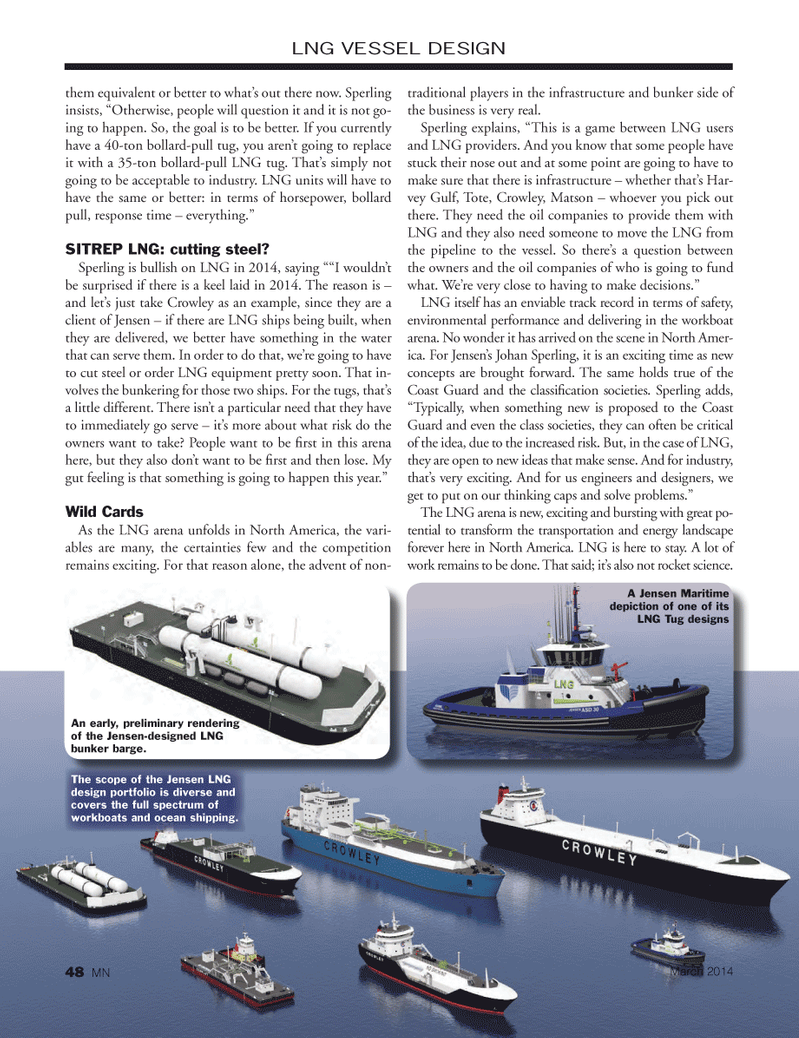
Page 48: of Marine News Magazine (March 2014)
Fleet & Vessel Optimization
Read this page in Pdf, Flash or Html5 edition of March 2014 Marine News Magazine
them equivalent or better to what’s out there now. Sperling insists, “Otherwise, people will question it and it is not go- ing to happen. So, the goal is to be better. If you currently have a 40-ton bollard-pull tug, you aren’t going to replace it with a 35-ton bollard-pull LNG tug. That’s simply not going to be acceptable to industry. LNG units will have to have the same or better: in terms of horsepower, bollard pull, response time – everything.”
SITREP LNG: cutting steel?
Sperling is bullish on LNG in 2014, saying ““I wouldn’t be surprised if there is a keel laid in 2014. The reason is – and let’s just take Crowley as an example, since they are a client of Jensen – if there are LNG ships being built, when they are delivered, we better have something in the water that can serve them. In order to do that, we’re going to have to cut steel or order LNG equipment pretty soon. That in- volves the bunkering for those two ships. For the tugs, that’s a little different. There isn’t a particular need that they have to immediately go serve – it’s more about what risk do the owners want to take? People want to be fi rst in this arena here, but they also don’t want to be fi rst and then lose. My gut feeling is that something is going to happen this year.”
Wild Cards
As the LNG arena unfolds in North America, the vari- ables are many, the certainties few and the competition remains exciting. For that reason alone, the advent of non- traditional players in the infrastructure and bunker side of the business is very real.
Sperling explains, “This is a game between LNG users and LNG providers. And you know that some people have stuck their nose out and at some point are going to have to make sure that there is infrastructure – whether that’s Har- vey Gulf, Tote, Crowley, Matson – whoever you pick out there. They need the oil companies to provide them with
LNG and they also need someone to move the LNG from the pipeline to the vessel. So there’s a question between the owners and the oil companies of who is going to fund what. We’re very close to having to make decisions.”
LNG itself has an enviable track record in terms of safety, environmental performance and delivering in the workboat arena. No wonder it has arrived on the scene in North Amer- ica. For Jensen’s Johan Sperling, it is an exciting time as new concepts are brought forward. The same holds true of the
Coast Guard and the classifi cation societies. Sperling adds, “Typically, when something new is proposed to the Coast
Guard and even the class societies, they can often be critical of the idea, due to the increased risk. But, in the case of LNG, they are open to new ideas that make sense. And for industry, that’s very exciting. And for us engineers and designers, we get to put on our thinking caps and solve problems.”
The LNG arena is new, exciting and bursting with great po- tential to transform the transportation and energy landscape forever here in North America. LNG is here to stay. A lot of work remains to be done. That said; it’s also not rocket science.
LNG VESSEL DESIGN
An early, preliminary rendering of the Jensen-designed LNG bunker barge.
The scope of the Jensen LNG design portfolio is diverse and covers the full spectrum of workboats and ocean shipping.
A Jensen Maritime depiction of one of its
LNG Tug designs 48 MN
March 2014
MN MAR14 Layout 32-49.indd 48 2/21/2014 3:30:11 PM

 47
47

 49
49
